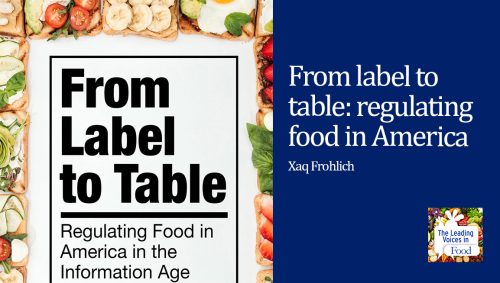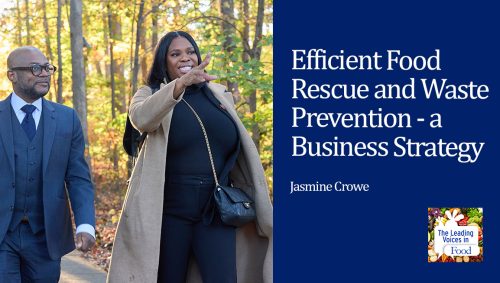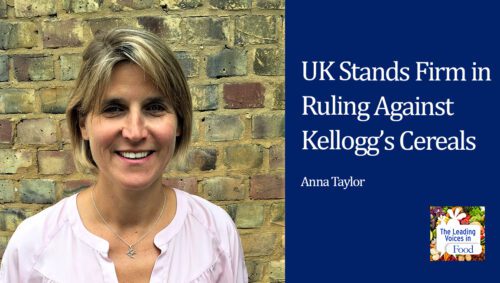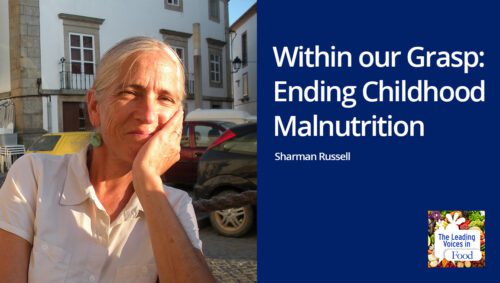The Leading Voices in Food
E61: Awilo Ochieng Pernet on the Global Complexity of Food Safety
Food safety is a very important international issue and few people have been as engaged on this topic as our guest today, Awilo Ochieng Pernet, a senior advisor on international matters related to food safety, nutrition, water and veterinary issues at the Swiss Federal Food Safety and Veterinary Office.
Subscribe: Apple Podcasts | TuneIN | Google Podcasts | SoundCloud | PocketCasts | Radio Public
Tags: Food Safety & Food Defense | International Food & Ag Policy |

Awilo Ochieng Pernet studied law, human nutrition and international food regulatory affairs. She is now a senior advisor on international matters related to food safety, nutrition, water and veterinary issues at the Swiss Federal Food Safety and Veterinary Office. She has also had a distinguished international policy career, particularly with a Codex Alimentarius Commission in the international food standards setting organization, which is part of the Food and Agriculture Organization and the World Health Organization of the United Nations.
Interview Summary
So you have been involved in the development of international food safety and quality standards for nearly 20 years now. And I know that you’re very strongly committed to food safety advocacy work, protect the health of consumers, and have carried out food safety awareness raising missions in numerous countries. What are the main challenges that you see related to unsafe food and who should be involved to ensure that the food is safe? Thinking all the way from primary production consumption.
Thank you very much for the introduction and for that question. Food safety is an issue of great concern to the entire world’s consumers because we all need to have access to safe and nutritious food every day. According to the Codex Alimentarius Commission, food safety is the assurance that food will not cause harm to the consumer when it is prepared and/or eaten according to its intended use.
Now the issue is that today’s food supply system is extremely complex and it involves a range of different stages including on-farm production, slaughtering, harvesting, processing, storage, transport, distribution, and until their food reaches the consumer. There are so many possibilities for contamination to take place along the entire food chain. According to the World Health Organization, there are more than 200 diseases are spread by contaminated food. It’s incredible. One in 10 people all over the world will fall sick each year after eating contaminated food. The WHO also estimates that 420,000 people die each year as a result of contaminated foods. So this is really critical and it’s very serious. It is also estimated that children under five years of age are at particularly high risk.
Considering the food chain that I mentioned earlier, we have to ensure that food is safe along the entire food chain. So all the stakeholders from primary production to consumption, including the consumers ourselves, we have to take measures to ensure that food is not contaminated. That’s where the challenge is because there’s so many stakeholders and so many opportunities for food to be contaminated along the entire food chain. So everybody has to remain vigilant. They have to apply the good hygiene principles and practices to ensure that food is not contaminated. And then at the end of the chain, we consumers also have to take measures to ensure that we do not contaminate food, which we bought from the shops or from the market which was safe, but due to the poor handling practices at home, we render it unsafe and it make us fall sick.
Are there particular countries or regions of the world where there’s a special vulnerability to food safety issues and why might that be?
Yes. According to the WHO study that I had mentioned earlier, which was a FERG report, F-E-R-G, which came out in 2015, there is no area in the world, which is what I would say, which is immune or protected from foodborne diseases. Both developing and developed countries are exposed to contaminated food. Now, however, in that report, we clearly stated that the African region and also South East Asian region, they bear the heaviest burden of foodborne diseases. However, developed countries, for example, even here in Switzerland, we also have our challenges and I know that even in the United States of America and other European countries, it is a priority to ensure that food that is sold to consumers is safe. So you see the scale of unsafe food made at home in the home setting, but also in mass catering, it can really have very dramatic consequences on the consumer. In Africa, Asia, they really have to improve also in their hygiene and raise awareness among food handlers, street food vendors, but we also have challenges in developed countries.
With food supply chains being so global, has that made the problem more complex?
Oh yes it has. Because food which is produced in one part of the world is shipped, sold all over the world in such a short period. So if it’s contaminated at the source, all the areas where it’s distributed will be affected. We saw that recently, two or three years ago with the melamine crisis with the milk from China. We realized with a recall that every region of the world was affected, you see? So the globalization of the food chain and the food supply has really made it more difficult and it’s even faster. But the good thing is that there are measures being taken. There’s a lot of collaboration at the international level, information networks and rapid exchange of information so that food can be recalled before it gets to the plate of the consumer and that way they can do some harm reduction.
So countries will have their own food safety standards and try to monitor those carefully as possible. You mentioned a little bit some of the international things that can be done. Who are the major players on this Codex certainly, but who are the other players that are important?
Indeed, the Codex Alimentarius develops the food standards, which are approved by the 189 members, which I would say almost the entire world. But from that stage, then the members themselves have to take it upon themselves to translate these international standards into the national legislation. And then they have to ensure, the authorities have to ensure, that all the stakeholders along the food chain implement these standards. At that level, it’s really the national authorities who have to ensure that the standards, the national standards, which now reflect the Codex standards or take into account the Codex standards, are implemented.
At the international level, the organizations which coordinate for example, coordinate cases of recall and in case of food contamination across borders, there is the Food and Agriculture Organization and the World Health Organization who have a network, which is called the INFOSAN. Codex members and many countries are members to that group. So if there is an issue is brought to their attention, they disseminate the information through that network so that the authorities then try to ensure that they take the necessary measures to prevent the contaminated foods from reaching the consumer.
So during your time as chairperson of the Codex Alimentarius Commission, in 2015, you called for the establishment of a World Food Safety Day. Then three years later in 2018, the United Nations General Assembly adopted resolution designating June 7th as World Food Safety Day. Can you talk about what actions that you recommend in order to ensure the goal of raising awareness about food safety is achieved and that food safety becomes a priority around the world?
Well, first of all, thank you very much. The adoption of that resolution is a tremendous achievement for the entire world and above all, for the entire world’s consumers because at the end of the day, we are the ones who are going to consume the food and we do not want to endanger our health. I would like to say that the main goal is to raise awareness, to raise awareness about the importance of food safety. I’d like all relevant stakeholders to engage, to really take concrete measures to ensure food safety and above all, to be committed to food safety. So we should try to achieve a food safety culture. You see, since there’s so many players, we have to address all the players, including the consumers of course. Many of the things are not in our hands as consumers because they are the food producers who also have to ensure that they produce the food in a safe manner and then the processes and the transporters and food handlers. So there are many, many stakeholders. Each one has a specific role to play to ensure that the food that they handling is safe so that ultimately, the consumer’s health will not be endangered by the food that a consumer will take.
Now while for safety, they should also help us to maybe demystify food safety. We have achieved the World Food Safety Day, but I would like to say that we are the beginning of the work now. You know? We need to see how we can achieve the knowledge and reach people in their homes, reach people in their kitchens so that the street food vendors know food safety is important, “am I doing the right thing?” You know? So we have a food safety culture and that it’s really part of our being and this is what we have to do now to ensure that indeed, while food safety there is each day, really live food safety, have that food safety culture in us, in us.
So you mentioned consumer several times in that previous comment and it’s obvious that they have an important role to play in preventing foodborne illnesses as well as the producers and suppliers. What steps can consumers take to make sure that they protect themselves and their families from food poisoning?
I know from talking to so many consumers that they’re interested in food safety, but sometimes they don’t have the knowledge or the information to take the necessary steps. Sometimes they’re also, they’re repeating behaviors that maybe they saw or they learned, which are not necessarily the right behaviors to protect themselves. Now we’ll talk about the international level. At the World Health Organization level and also the Codex level, we promote the five keys to safer food. Of course the first key is cleanliness. Keep clean, hygiene, washing your hands before handling food and of course often during the preparation, so protecting your kitchen areas and food from insects, pests and other animals. The second key is separating raw from cooked, especially separating raw meat, poultry and seafood from other foods of course, to avoid cross contamination. And then the third key to cook thoroughly because we know that under cooked products, especially meat, poultry, eggs and seafood will cause foodborne diseases.
Then the fourth key is to keep food at safe temperatures. Consumers should not leave cooked food at room temperature for more than two hours. The bacteria, the microorganisms will grow and multiply and then the food will be unsafe. We should refrigerate food promptly. If we remove food from the fridge, we should heat it properly to kill any microorganisms which would be in the food. The fifth key is to use safe water and safe ingredients and raw materials to ensure that once we have followed all those five steps, we enjoy food, which will not endanger our health.
So those are the five keys to save her food from the World Health Organization, but I know that different countries have different approaches to consumer education and information. I think what is very crucial is that whatever information is given it respects the cultural setup of the target group or the target audience, and also that the materials which are used, that they correspond to the cultural understanding and the setup of the target group. What might be appropriate and relevant to a European audience would not be the same for Africa.
I’ll give you an example. There’s a case in Africa when they used a chat illustrating the five keys to safer food. So the first key was illustrated just simply by tap and running water and hands under the tap. You see, just that picture. For people in Europe, for people in the US, in developed countries, I mean this is evident, that is clear. We see taps all over the place, but in a setting in an African village where they do not have running water, they do not have taps, they get water from the borehole, this image does not evoke anything in their minds. These are the things where you have to adapt the resources, the messages to your target group. Now, of course, washing your hands with soap, they will understand that, but don’t illustrate that with the water coming from a tap because they don’t know what this is.
The second example was also from Africa where on one of the charts, when they said, “Keep food at a safe temperatures,” and they use a thermometer. But for many people in the village, the thermometer, they only see it when they go to the hospital, when they have to take their temperature to see when they have fever. So this group of people said, “Oh, but if we do all this, we’re going to fall sick.” So they do not understand the message.
Well, those are fascinating examples. When people think about food safety issues, they’re mainly thinking about things like bacteria and viruses, but food allergies are also an interesting issue. How are these taken into account by work at Codex and what’s being done around the world?
Oh yes. It is an issue, which is also very dear to me because I believe that we need to do more. We need to do more to protect consumers against suffering from these allergies and sometimes people are aware of the allergy that they have and sometimes they do not. They’re not aware of it, and they only learn that they’re allergic to certain food when they’re in a very critical condition. In the Codex Alimentarius, the Codex Committee on Food Labeling developed a set of, a list in fact, of foods which are acknowledged internationally to cause allergic reactions. However, right now, this list is being reviewed because the international community believes that maybe it’s not sufficient to really protect the consumers. Sometimes it can be difficult, especially we talked about the international trade, that certain allergies are not taking into account when foods are shipped from one area to the other. So that is an area that has to really be improved on.
Just one final question. Thank you for that description as well. Can you briefly explain how food fraud can affect food safety?
Oh, yes. Food fraud, of course it’s a criminal activity. We have a very recent example here in Europe. Authorities in Italy and Serbia came across a criminal group, which was using contaminated food and rotten raw materials to make food which was being labeled as organic. Here, this is really a clear example of how food fraud can threaten our safety because a person, that consumer will find a product on which is labeled, “fresh organic orange juice,” but this product, first of all, is not organic, but it’s also unsafe because they used in this case, decomposed apples, which are found which are contaminated with mycotoxins and other toxic chemical substances and suitable for human consumption and dangerous to public health. So that’s how food fraud really impacts our health, that we as consumers, it’s difficult for us to act on that. We have to rely on our authorities.






